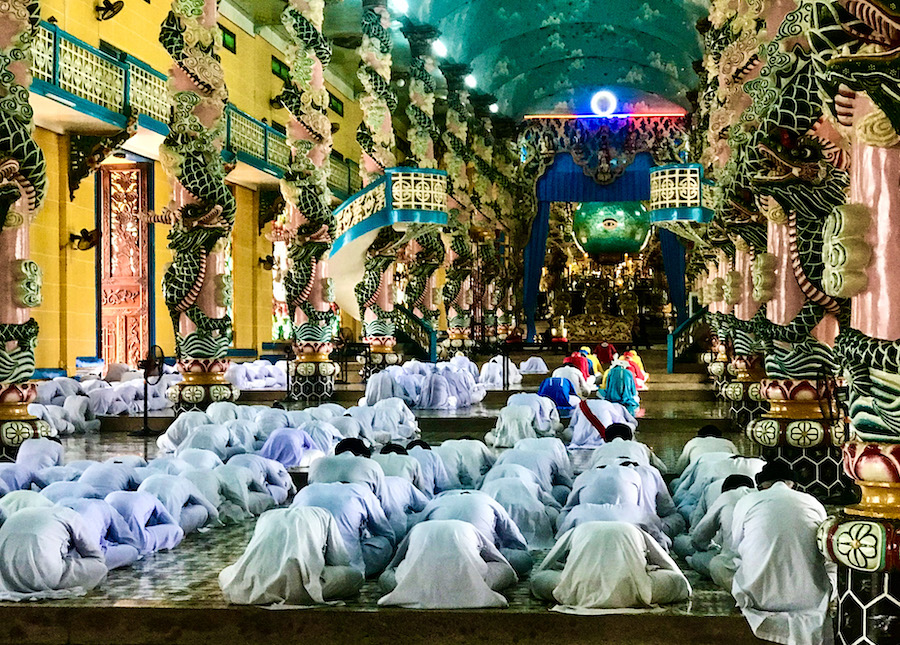
During Cao Đài services four times daily, scores of worshippers in white cloaks and black hats chant and prostrate themselves. The object of devotion is a giant eye, set into the middle of a great globe-like orb, luminescent blue and green like Earth itself. Photo by John Gottberg Anderson
By John Gottberg Anderson
A colossal figure in alabaster rising majestically from a hilltop outside Danang stares regally across an armada of fishing boats into the vastness of the South China Sea. She is Quan Âm, whom the Vietnamese call “the Lady Buddha.”
In the mother temple of the Cao Đài religion near Tây Ninh, 50 miles northwest of Ho Chi Minh City (Saigon), scores of white-cloaked worshippers chant and prostrate themselves before a giant eye set into the middle of a great globe-like orb.
In the flamboyantly decorated parlor of a home in Bảo Lộc, a small town at the edge of the Central Highlands, a young Tứ Phủ spirit medium dances before an altar. Her colorful brocaded silk costumes invoke the goddesses of heaven, earth, water and mountain.
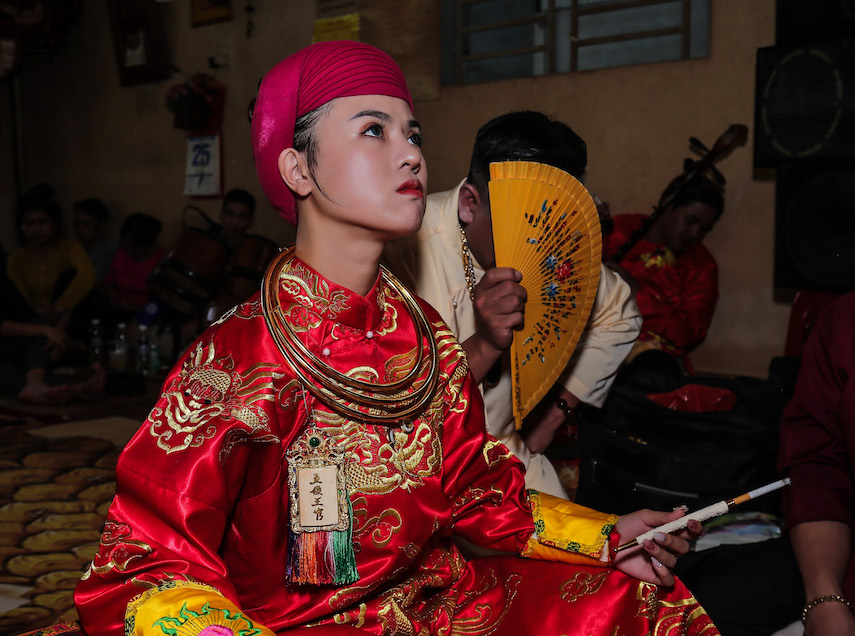
Clad in red brocade to welcome the mother goddess, Lâm Nhi prepares for the hầu bóng trance ritual. In this, she will become a medium between humans and goddesses of the Four Palaces, in the spiritual realm. Photo courtesy Lâm Nhi
There is a diversity to the religious beliefs of Vietnam that defies expectations, especially in a communist society where the array of creeds are tolerated but hardly embraced. Traditional Buddhism heavily mixes elements of Taoism, Confucianism and ancestor worship. Catholicism has adapted the faith vacated seven decades ago by French colonials to shape a uniquely Vietnamese understanding of the gospels. Polytheistic goddess worship is integral to traditional Viet folk religion. Faith systems like Cao Đài assimilate a variety of philosophical elements.
Officially, Vietnam’s government speaks of religious freedom. Yet only 16 organizations are authorized by the state. Others are considered threats to national security: Uncontrolled, they may encourage free speech. Vietnamese citizens, ever-ready to please party officials, vigilantly monitor what their neighbors are doing.
But you’re safe if you’re a Buddhist or a member of one of the numerous unaffiliated splinter groups such as Hòa Hảo. So, too, if you’re Catholic, Protestant, Mormon or Seventh-day Adventist; a Muslim, Brahman (Hindu), Baha’i or Cao Đài. Jewish? It’s not on the list of sanctions, but an estimated 300 expatriates are able to practice their faith undisturbed. Russian Orthodox? Not on the list. Jehovah’s Witnesses? Forget it. And the respective spiritual beliefs of Vietnam’s diverse minority populations, sometimes collectively called Montagnards, are ignored or even suppressed by provincial police and the Vietnamese army.
The Eye of Cao Đài
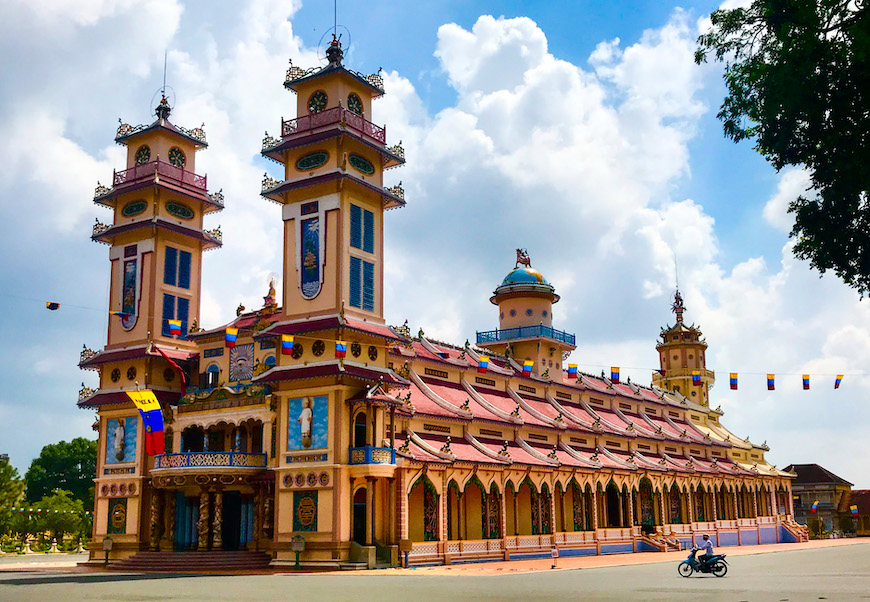
The mother temple of Cao Đài, a religion founded by spirit mediums in the 1920s, is a landmark in Tay Ninh, 50 miles northwest of Ho Chi Minh City. The faith matches 19th-century European mysticism with Chinese Buddhism, Taoism and Confucianism. Photo by John Gottberg Anderson
Those religions that have won approval, however, have fascinating stories to tell … and to share with visitors willing to venture a bit off the beaten tourist track.
The mother temple of Cao Đài is a landmark in Tây Ninh — or, more specifically, its upscale suburb of Hoà Thành. Called the Holy See, in obvious reference to the Vatican, it is open day and night. It is most intriguing to visit the sanctuary during prayers, which are offered four times daily, at noon, 6 p.m., midnight and 6 a.m. Then, humble devotees bow in unison to the central globe. It is luminescent blue and green like Earth itself, elevated on a dais where another church might place an altar.
Within that sphere is the eye of God. More specifically, it’s the left eye of God, maintaining perfect vigilance. The eye appears in every window and doorway, framed by the holy trinity of a perfect triangle, rays of imaginary sunlight reaching beyond its universe. It’s like the Eye of Providence, the one in the pyramid on the Great Seal of the United States. The eye whose gleam illumines obscure Latin mottos on the back side of the dollar bill. He watches everyone, everywhere. Yes, He. Him. Because the right eye, the unseen eye, is Her. The Mother Goddess.
Between services, individual congregation members are proud to share their beautiful house of worship. Red, gold and sky blue dominate the color scheme. Mythological dragons and cranes wrap themselves around gaudy columns. Fanciful carp spout upward, dreaming that they, too, might someday be dragons.
The avatars of the Cao Đài faith are not whom you might expect. For one, there’s Victor Hugo, the 19th-century French author of Les Misérables and The Hunchback of Nôtre-Dame. He has been assigned the post-mortem post of “spiritual chief of the foreign missions of Caodaism.” Along with early 20th-century Chinese patriot Sun Yat-sen and 16th-century Vietnamese poet Nguyen Binh Khiêm, Hugo is a “signatory of the Third Alliance Between God and Man.” They are said to be guiding humanity into a new era of enlightenment, ably assisted by Joan of Arc, Louis Pasteur, William Shakespeare and Vladimir Lenin, to name but a few.
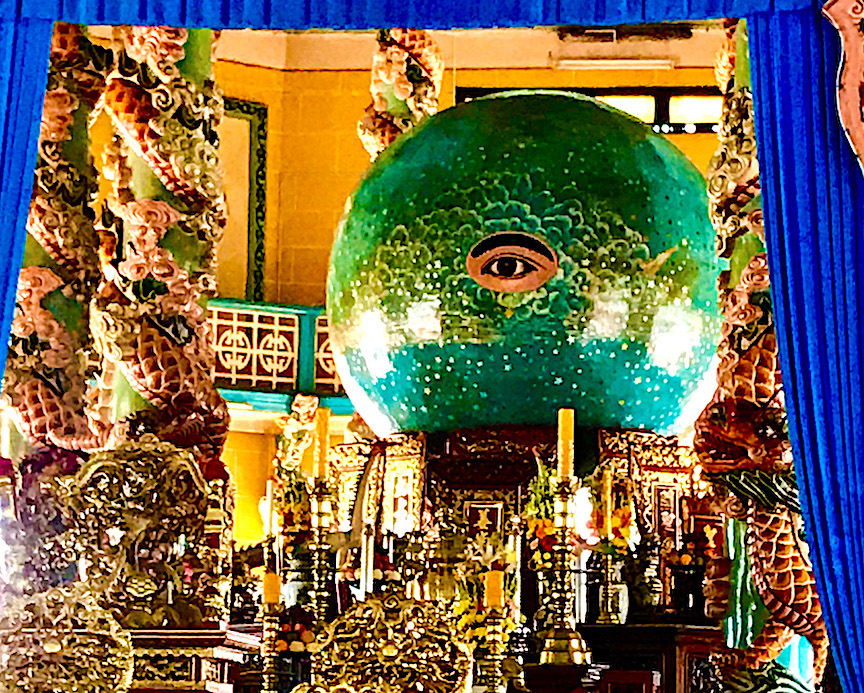
The left eye of Cao Đài (“Highest Power”) maintains a 24-hour vigilance over parishioners at the religion’s Holy See in Tay Ninh. Caodaism has an estimated 3 million followers, the vast majority in Vietnam. Photo by John Gottberg Anderson
Caodaism has an estimated 3 million followers, the vast majority in Vietnam. Founded by spirit mediums in the 1920s, the religion merges 19th-century European mysticism with Chinese Buddhism, Taoism and Confucianism. Its objectives are honorable: the unity of all religions; the harmonious balance of the universe; the coupling of god and mankind, love and justice (and karma).
The two main gods, Cao Đài (“Highest Power”) and Diêu Tri Kim Mau (the Mother Goddess), are considered equal creators of the universe, the yin and yang of humanity. If there ever was a duotheistic religion, this is it.
The Lady Buddha
Ah, the Mother Goddess. Her presence reaches much further than her eye can see from the Linh Ứng pagoda on Da Nang’s Sơn Trà Mountain. That statue, the tallest in all of Vietnam, rises 220 feet atop a 35-foot lotus pedestal and can be seen all along the shoreline from many miles away.
This is a place of Buddhist worship, but its central image, ironically, isn’t the Buddha, although locals often refer to the sculpture as Lady Buddha. In fact, it is a representation of Quan Âm, the goddess of compassion, known as Kuan Yin in China, Kannon in Japan and Avalokiteshwara in India.
Completed in 2010 along with the pagoda and monastery, she appears to attract respect equal to or greater than the Buddha himself. Indeed, Quan Âm’s enormous icon dominates the pagoda grounds, easily overshadowing a whimsical image of the so-called Laughing Buddha that sits nearby on his own lotus pedestal.
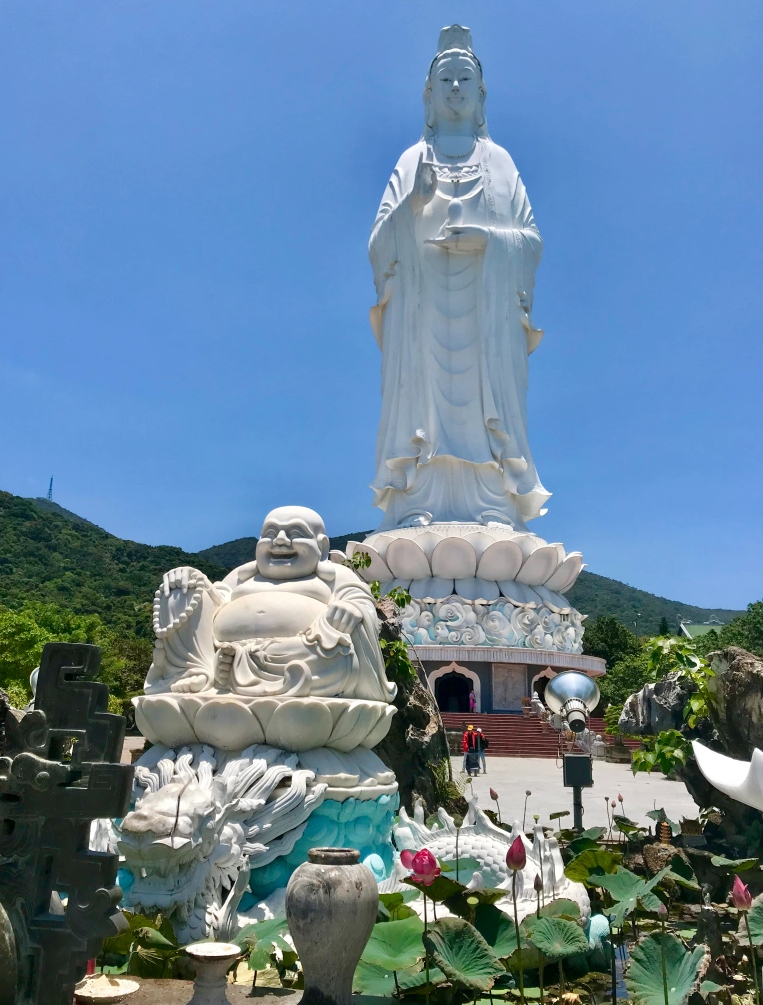
Vietnam’s tallest statue is a 220-foot-tall homage to Quan Âm, the goddess of mercy whom Vietnamese often call “the Lady Buddha.” The centerpiece of the Linh Ứng pagoda at Da Nang, the statue easily overshadows a whimsical image of the so-called Laughing Buddha. Photo by John Gottberg Anderson
Devotion to Lady Buddha is a common element in Vietnamese Buddhism, a syncretic faith that weaves in elements of Taoism, animism, ancestor worship and folk religion. Although not every place of Buddhist worship portrays her as prominently as Linh Ứng, Quan Âm is inevitably accorded a place of honor wherever prayers are offered, her image often more prominent than the religion’s namesake. Oversized statues of her may be seen all over Vietnam.
In the Mahayana tradition of Buddhism, Quan Âm is a bodhisattva, esteemed for her compassion. Devotees bring incense or fruit and ask her merciful assistance in making their lives better. That Laughing Buddha? He’s actually another bodhisattva, an eccentric 10th-century Chinese monk named Budai. In his saintly incarnation, he carries a sack that holds food, sweets for children and the sadness of the world. His swelling belly represents wealth, happiness and good luck.
But there’s no scarcity of images of Gautama Siddhartha, the 5th Century B.C. Nepali prince who became known as the Buddha, “The Enlightened One.” Most frequently, he is shown seated in the lotus position, meditating under a bodhi (fig) tree, or sometimes reclining as he slips quietly into nirvana — in other words, as he dies.
This isn’t the philosophical Buddhism of the Four Noble Truths and the Eightfold Path to Enlightenment. The practice of a religion in its daily application is often very different from its scriptural foundation. But Vietnamese don’t question the inconsistencies between Buddhist, Taoist and Confucianist beliefs. Indeed, Taoist gods are often worshipped at Buddhist temples where graphic displays of the punishments of hell sternly warn against defying Confucian laws of filial piety. This amalgamation is known in Vietnam as tam giáo, or “triple religion.”
At the historic Jade Emperor Pagoda in Saigon’s District 1, for instance, those who read Chinese characters will discover the phrase, “The light of Buddha shines on all,” in the main hall where Taoism’s King of Heaven sits in a fog of incense smoke. Off to the king’s side is the Hall of the Ten Hells, its carved panels illustrating the fate that awaits those who do evil. At Chùa Sắc Tứ Khải Đoan, the largest pagoda in Buôn Ma Thuột in the Central Highlands, there are numerous representations of both the historical Buddha and fierce Taoist guardians. A short walk away at the Hong Phuoc pagoda, visitors are greeted by the Laughing Buddha, small children climbing all over his ample body. Nearby, shaded by trees, Quan Âm smiles beatifically.
Mother Goddess Worship
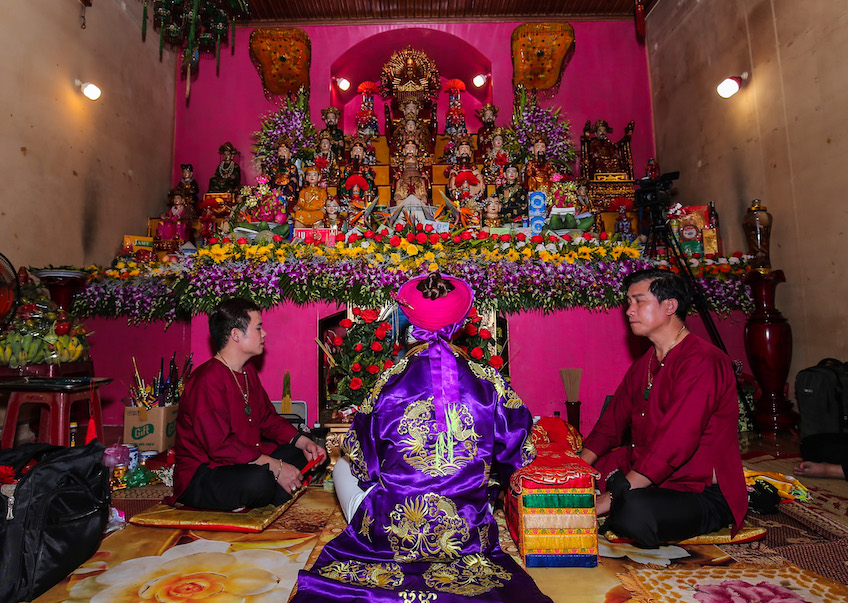
A Tứ Phủ priestess dressed in purple silk kneels at the altar of a home temple in Bảo Lộc, in Vietnam’s Central Highlands. Đạo Mẫu cults such as this one are a part of Vietnamese folk tradition and are recognized by UNESCO as an “intangible cultural heritage.” Photo courtesy Lâm Nhi
In Catholicism as well as Buddhism, the image of the Mother — in the Christian case, the Virgin Mary — is often elevated above that of the religion’s namesake. Whether intended or not, these faiths syncretize the shamanic beliefs of Viet folk religions with Buddhist and Christian traditions.
Đạo Mẫu (“Taoist Mother”) has been a part of Vietnamese culture at least since the 16th century. Recognized by UNESCO as an “intangible cultural heritage,” the practice is seen as contributing to respect for women’s independence. Although the Vietnamese government once suppressed the practice as superstitious, it has been permitted since 1987.
Lâm Nhi, 27, lives in two worlds. One is Ho Chi Minh City, where she is an entertainer and a teacher. The other is in her hometown of Bảo Lộc, 130 road miles northeast. There, like her mother and younger sister, she is a thanh đồng, a priestess of the vibrant and shamanistic Tứ Phủ cult — a medium between humans and the goddesses who rule the Four Palaces.
In performing the hầu bóng trance ritual after a period of meditation, Nhi assumes the persona of each of the main Tứ Phủ goddesses: heaven, earth, water and high mountains. She dresses like them and, as she changes her brilliant wardrobe from red to yellow, white to green, invites them to reveal their presence to her. When she receives them, she is able to communicate between the physical and spiritual worlds, getting answers to questions posed by supplicants at the family temple.
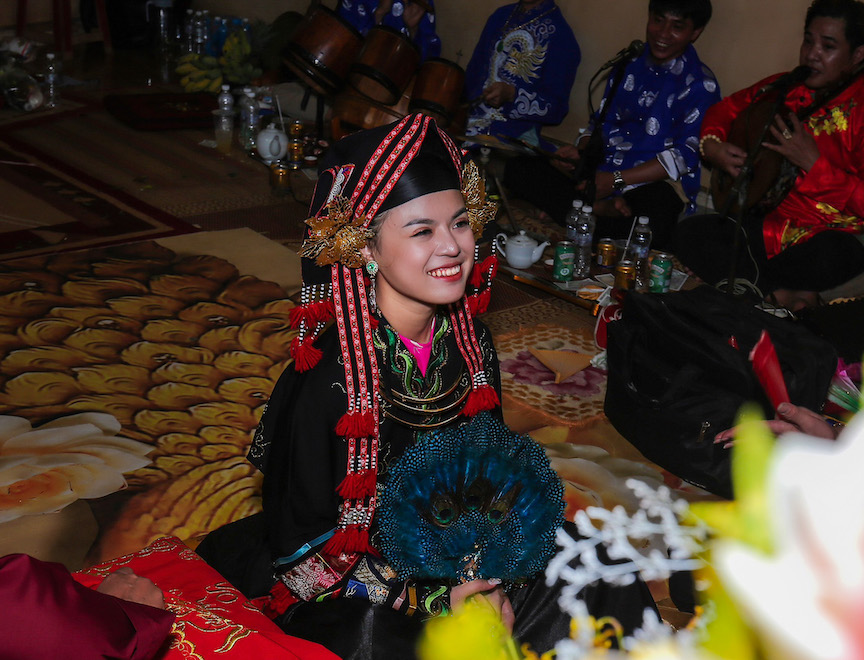
Relaxed after her ritual, Lâm Nhi makes offers to each of the main Tứ Phủ goddesses: heaven, earth, water and high mountains. She hopes they will bless her with happiness and good health. Photo courtesy Lâm Nhi
Nhi dresses in red brocade for Lieu Hanh, the mother goddess of heaven. She will make offerings, burn incense, dance, tell stories and sing in riddles. The actions are not hers, she insists: They are those of the goddess spirit acting through her. She hopes the goddesses will bless her with happiness and good health for the rest of her life.
Hòa Hảo in the Delta
Another uniquely Vietnamese religion is Hòa Hảo, which still has a foothold in the Mekong Delta. It was founded in 1939 by a young monk, Huynh Phu So, who called for a return to the simpler Thai-Cambodian (Theravada) form of Buddhist worship, combining traits of ancient folk religion and herbal healing. He taught simplicity and austerity, with a message that humans don’t need priests or temples to communicate with a supreme being. Practitioners — an estimated 1.3 million today — pray four times daily in their homes or at tiny altars.
Huynh believed people don’t need governments, at least not French colonial rulers nor Viet Minh communist leadership. By the mid-1940s, Hòa Hảo had become a militantly anti-political group. Huynh was kidnapped and executed in 1947. Some followers believe he’s not dead, and that he’ll return in time of crisis.
The center for this faith is An Giang province, including the towns of Long Xuyên and Châu Đốc. But as it’s a private creed, there’s little or nothing for visitors to see, unless they make friends and are invited into a family home.
East-West News Service contributor John Gottberg Anderson has recently written about Vietnam’s booming coffee industry and the Áo Dài, the elegant dress worn by Vietnamese women

